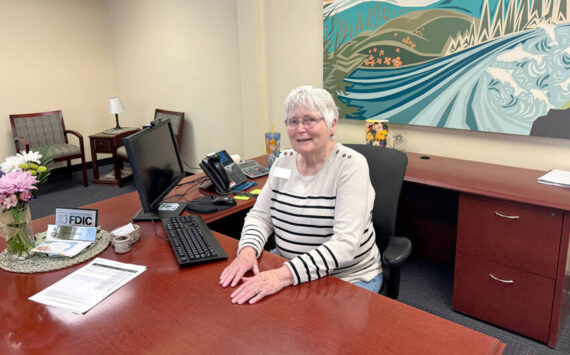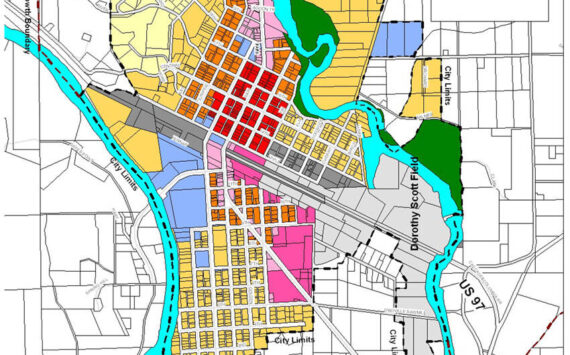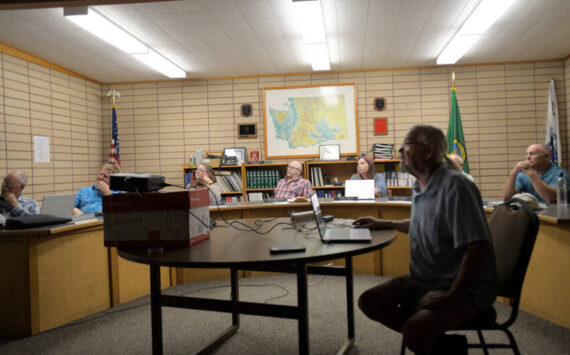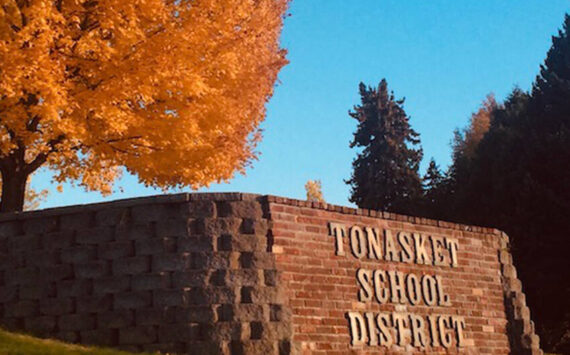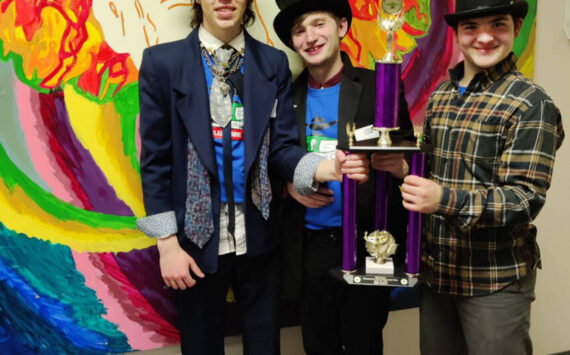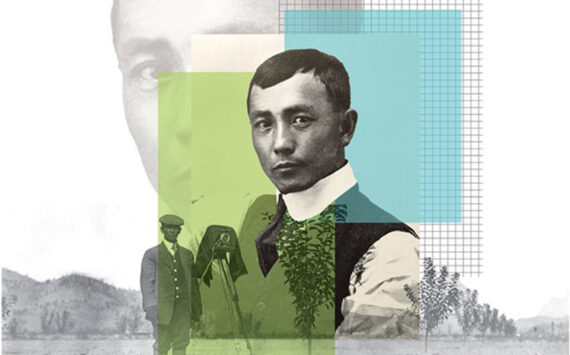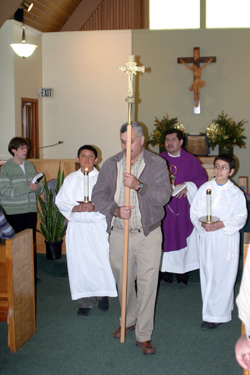 Photo by Gary DeVon
Photo by Gary DeVon
The Immaculate Conception Parishcelebrated its centennial with a special mass, followed by a potluck supper.“How can we loo” title=”674a” width=”” height=”” class=”size-FULL”>
Photo by Gary DeVon
The Immaculate Conception Parishcelebrated its centennial with a special mass, followed by a potluck supper.“How can we loo
OROVILLE – Like the town, Oroville’s Immaculate Conception Parish celebrated its 100th birthday this year, but the area’s connection with Catholicism predates the town by nearly seven decades.
The parish celebrated with a special bi-lingual Mass last Sunday, as well as good food and history. Mass was followed by a potluck supper and some history of the church in Oroville and of the early day missionaries who traveled the Okanogan Valley as far back as 1839, first bringing Christianity to the area, according to local historian Jim Lynch, a former member of the Oroville congregation.
Lynch, who grew up in Oroville, now lives in Moses Lake with his wife Ruth. The two returned to Oroville for the celebration and during the potluck Lynch related some of the long history of the Immaculate Conception Church and the missionaries and priests who came before construction first began on the old church building in 1908.
“In order to appreciate the early history and sacrifices of establishing the Catholic Faith in the Okanogan Valley, and in particular our parish and the early missions in this area, we must take a journey back in time 169 years ago to 1839,” said Lynch.
That was the year Father Pierre-Jean deSmet, S.J. traveled through the valley on his quest for souls, according to Lynch, who has done much research into Oroville’s history.
“He stopped at what is now Oroville and ministered to the local Indians. Again, he came to our future parish and preached the faith to several Indian tribes at the mouth of Tonasket Creek, just north of Oroville, where Chief Tonasket’s ancestral village and council grounds ere located,” Lynch said.
It was during this visit in May of 1842 that deSmet baptized 106 children and several adults. He called the area “The Plain of Prayer,” said Lynch.
The next Jesuit Missionary to visit Oroville while on his way to minister to the various Indian Tribes in New Caledonia, in what is now British Columbia, was Father John Nobili, S.J., accompanied by a novice Brother in 1845. After baptizing nine Indian children, including the children of a Shuswap Indian Chief at Fort Okanogan in July, they traveled north through the Okanogan Valley with the Hudson’s Bay Company fur brigade, according to Lynch.
“They spent the night at Oroville which was the regular Hudson’s Bay Company camping grounds for their fur brigade consisting of 300 to 400 pack horses. Nobili visited Chief Tonasket’s large Indian village and baptized several children and adults,” Lynch said.
Oroville went without a traveling priest for several years until Father Urban Grassi, S.J. visited the area in the late 1800s, said Lynch.
“Mary Bottomely was the first white child to be baptized in what is now Oroville in November 1885 by Fr. Grassi,” said Lynch.
The priest followed in Nobili’s footsteps and traveled throughout the Okanogan Valley on horseback leading a packhorse and ministering to and baptizing Indians wherever he found them, according to the historian.
In 1885 Father Stephen de Rouge, S.J. visited the area and established St. Joseph’s Indian Mission at present day Ellisforde. The first mission was constructed of cottonwood logs and as many as 500 Indians would attend Mass on Corpus Christi Sunday, Lynch said.
“The whole village would attend, all riding horses and bringing their food, clothing and tipis. They would stay several days while Fr. de Rouge taught them their prayers and baptized many of them and performed marriages,” Lynch said, adding that the priest was well received because he could speak their language fluently and understood their customs.
Later in 1886 the priest established St. Mary’s Indian Mission on Omak Creek, five miles east of Omak on the Colville Indian Reservation. While St. Mary’s remains active today, all that remains of the old Ellisforde Mission are gone except for the Indian cemetery, said Lynch.
Fr. de Rouge ministered to the Indians and homesteaders of the Okanogan Valley from 1885 until 1905. On one of his many visits to the Oroville area he celebrated Mass in the Dan Driscoll home on Driscoll Island just south of Oroville. Driscoll homesteaded the island in 1869. The priest also celebrated Mass in many private homes and business places in Oroville before construction on the first church started in 1908, said Lynch.
The priest established St. Michaels Church in Loomis and Father Thomas Ewing Sherman, S.J. was the resident priest there from 1915 to 1919. He was the son of General William Tecumseh Sherman of Civil War fame, according to Lynch.
“My grandfather and family homesteaded on the north side of Whitestone Lake east of Loomis in 1905. They boarded Fr. Sherman’s saddle horse at their ranch and took him to Oroville and Tonasket many times in their 1916 Model T. Ford to celebrate Mass,” he said.
Lynch said that according to the Diocesan records Oroville and the surrounding area was not served by a priest on a regular schedule prior to 1907, but after June of that year a priest would celebrate Mass once or twice a month at Oroville and Molson. As the churches there were not yet built, Mass was said in private homes or places of business.
In 1908, Lynch’s grandfather, James Lynch, accompanied Fr. Van der Velden on his many trips to solicit money to build the first Catholic Church in Oroville. The building project was started in 1908 and was completed in 1913 and blessed by Bishop A.F. Schinner, D.D. of the Spokane Diocese on Oct. 4, 1914. The old original church building, now privately owned, is still standing at the corner of Fir and 10th Street.
In a 1915 letter signed by the Bishop to Father M.J. Kasper, pastor of Oroville Immaculate Conception Church, the Bishop includes a complete list of the mission and stations assigned to the Oroville Parish at the time. These included missions with churches in Oroville, Ellisforde, Loomis, Molson, Tonasket, Brewster and Winthrop and stations without churches in Chesaw, Havillah, Knowlton, Olema, Pateros, Twisp and Bridgeport.
“To attend to these locations without adequate transportation over 93 years ago seems like an impossible task, but by the grace of God it was accomplished,” said Lynch.
Lynch said many of the small churches and missions assigned to the Oroville Parish closed due to lack of parishioners and the lack of a priest.
Fr. Joseph Brunner was the local priest in Oroville from 1937 to 1948. While he was stationed here he built the first Catholic school in Oroville located at 16th and Main St., which is the location of the present Catholic Church. This was also the location of the first airport in Oroville in the 1930s before the school was built, Lynch said.
According to Lynch, the lumber for the school was salvaged from the old Molson Catholic Church, which had not been used in many years. It was torn down and the lumber hauled to Oroville by local parishioners. Many church members were involved in building the school, which saved on the cost of materials and labor, he said.
The school was operated from 1946 to 1956 by the Dominican Sisters who taught grades one through eight. The school closed due a shortage of Sisters to teach the classes and those that remained were transferred else
where, Lynch said.
“Since the school was empty and no longer in use and needed repairs and since the original Catholic Church also needed extensive repairs, it was decided to build a new church on top of the school’s full basement which was concrete,” said Lynch. ” By doing this the cost of the constructing a new church and basement was greatly reduced.”
Lynch recalled being an alter boy with his friend Peter Kammers. Back then Mass was said in Latin and on Saturdays the priest would teach the boys Latin in the rectory where he lived so that they could answer in Latin in response to the readings by the priest, said Lynch.
“During confirmation the children had to sit in the front pew while the Bishop grilled us on what we had learned. I was afraid I wouldn’t make it as we were all scared, but we all passed. The Sisters taught us our prayers. They did a good job,” Lynch said.
Lynch, whose family lived a block and a half from the old church, recalls being “volunteered” many times in the winter to light the fire in the large pot bellied stove in back of the church.
“I usually started it about 6 a.m. and used two foot cord wood. The stove would actually get red hot. It is a miracle the church didn’t catch on fire,” he said. “After a couple hours of warming up the yellow jackets in the attic came alive and started coming down through the metal ceiling of the church. They were landing on people in the pews and getting in their hair, but by the grace of God nobody got stung.”
Lynch told the parishioners that the property to build the old Catholic Church in Oroville was given to the church by George Hardenburgh and Harney and Lucy Hone. The deed was dated Aug. 22, 1907. The property to build the present church was sold to the Catholic Bishop of Spokane by the Town of Oroville for a sum of one dollar. This property consists of Lots 10, 11, 12, 13, 14, 15 and 16 of Block 7 and is dated June 3, 1946, according to Lynch. The deed is signed by the then Oroville Mayor, Ed Ryan, a member of the parish.
The property to build Holy Rosary Catholic Church in Tonasket was sold to the Bishop of Spokane on Dec. 28, 1928 for one dollar by Arthur Lund, a Tonasket banker.
“Tonasket was a mission of Oroville and is still part of the Oroville Parish,” Lynch said.
The new Oroville Immaculate Conception Church at 1715 Main was blessed by then Bishop Bernard J. Topel on Dec. 8 1957, the feast day of the Immaculate Conception.
